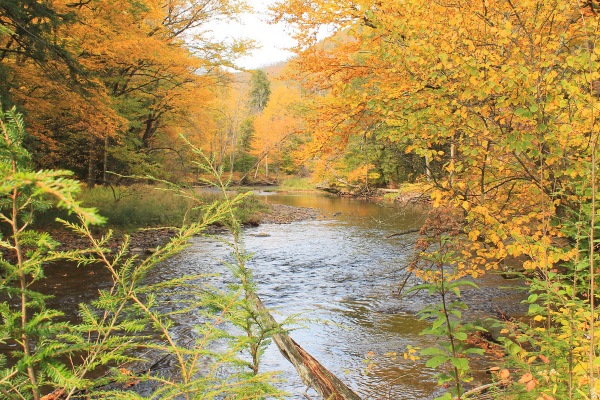Kinzua Creek is a 42.6-kilometer (26.5-mile) tributary of the Allegheny River situated in McKean County, Pennsylvania, USA.
Kinzua Creek, named after a Seneca hamlet, flows into the Allegheny Reservoir 10 miles (16 kilometers) upstream of Warren and a few miles upstream of the Allegheny River’s Kinzua Dam. Kinzua Creek is home to caddis hatches, stoneflies, sculpins, crayfish, and enormous salmon flies. There appears to be plenty of food for even the most picky trout.
The Kinzua Creek trail is a 1.2-mile challenging out-and-back at Kinzua Bridge State Park in Kane, Pennsylvania, which leads to the bottom of Kinzua Gorge and offers breathtaking views of the Kinzua Bridge ruins. Dogs on leashes are welcome on this trail, but they must pick up after themselves. For inexperienced trail users, a trail grade is easy with minimal challenges. For experienced hikers, the trail grade is embedded rocks or roots on the trail surface, steeper, and narrower. For pro hikers, the trail grade is steep and requires a significant physical effort. Wear supportive boots at all times. Serious mishaps can occur when people wear sandals, sneakers, “street shoes,” and “water shoes.”
Even though Kinzua Creek is only 40 feet wide on average, its deep pools, overhanging ledges, and undercut banks make it seem like a little mountain stream on steroids. If you are fond of fishing, practically anywhere along the stream is a perfect spot to catch fish. As it flows through a densely forested area, the water is cold enough to support trout all year. Kinzua Creek is a great place to fish at any time of year. If you enjoy nature and wish to unwind, this is the perfect place to create spectacular videos for your social media platforms.
Regarding topography, the stream’s upper sections run through Kinzua Bridge State Park, where the Kinzua Viaduct once spanned the creek before being damaged by a tornado in 2003. Previously, the longest and tallest railroad construction was about 2,053 feet long and 301 feet high. Unfortunately, Kinzua Creek is not stocked closer to Kinzua Bridge State Park, but trout make their way up there. The creek is accessible within the park but needs a hard downhill climb. The challenging trip required to reach the stream, take the Kinzua Skywalk, and look down at the valley from above. The skywalk is a 624-foot walkway with railroad tracks stretching out over Kinzua Gorge and a panoramic view. It is not for the faint of heart, especially as the overlook features a half-glass floor.
The site is also the former location of Kinzua, an unincorporated village that was destroyed during the construction of the Kinzua Dam. It once served as the border between Kinzua and (West) Corydon before both communities were disbanded in the 1960s. The upper portion of the stream flows through private property owned by forestry, gas, or mining firms. Due to the river’s inherent acidity and the legacy of the industry that formerly dotted its banks, there are no fish in the upper sections. This is why, with steady improvement over time, the mayflies in the stream do not have a wide variety.
Kinzua Creek lacks diversity, but it makes up for its uniqueness with the abundance of baetisca, or “armored mayflies,” in its population. The shell-like, diamond-shaped protective case gives them a hump-backed look. Baetisca are special, similar to stoneflies; they climb onto the ground before changing into adults, and hatches appear intermittently in May and early June.
The dark brown body and a combination of brown and black hackles match the species of baetisca discovered in Kinzua Creek. However, the fly’s body is tied thicker than usual, which frequently makes a difference in whether a particular trout accepts or rejects your offer. An oversized wing case on a beefed-up black Hare’s Ear nymph makes it quite similar to the baetisca nymphs for subsurface fishing.
Read More: The Brusio Spiral Viaduct in Switzerland












